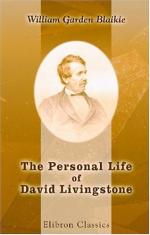The party, numbering about one hundred and sixty, proceeded up the beautiful river which on his former visit Livingstone had first known as the Sesheke, but which was called by the Barotse the Liambai or Leeambye. The term means “the large river,” and Luambeji, Luambesi, Ambezi, Yimbezi, and Zambezi are names applied to it at different parts of its course. In the progress of their journey they came to the town of the father of Mpepe, where, most unexpectedly, Livingstone encountered a horrible scene. Mpepe’s father and another headman were known to have favored the plan for the murder of Sekeletu, and were therefore objects of fear to the latter. When all were met, and Mpepe’s father was questioned why he did not stop his son’s proceedings, Sekeletu suddenly sprang to his feet and gave the two men into custody. All had been planned beforehand. Forthwith they were led away, surrounded by Sekeletu’s warriors, all dream of opposition on their part being as useless as interference would have been on Livingstone’s. Before his eyes he saw them hewn to; pieces with axes, and cast into the river to be devoured by the alligators. Within two hours of their arrival the whole party had left the scene of this shocking tragedy, Livingstone being so horrified that he could not remain. He did his best to show the sin of blood-guiltiness, and bring before the people the scene of the Last Judgment, which was the only thing that seemed to make any impression.
Farther on his way he had an interview with Ma-mochisane, the daughter of Sebituane who had resigned in favor of Sekeletu. He was the first white man she had ever seen. The interview was pleasing and not without touches of womanly character; the poor woman had felt an embarras de richesses in the matter of husbands, and was very uncomfortable when married women complained of her taking their spouses from them. Her soul recoiled from the business; she wished to have a husband of her own and to be like other women.
So anxious was Livingstone to find a healthy locality, that, leaving Sekeletu, he proceeded to the farthest limit of the Barotse country, but no healthy place could be found. It is plain, however, that in spite of all risk, and much as he suffered from the fever, he was planning, if no better place could be found, to return himself to Linyanti and be the Makololo missionary. Not just immediately, however. Having failed in the first object of his journey—to find a healthy locality—he was resolved to follow out the second, and endeavor to discover a highway to the sea. First he would try the west coast, and the point for which he would make was St. Paul de Loanda. He might have found a nearer way, but a Portuguese trader whom he had met, and from whom he had received kindness, was going by that route to St. Philip de Benguela. The trader was implicated in the slave-trade, and Livingstone knew what a disadvantage it would be either to accompany or to follow him. He therefore returned to Linyanti; and there began preparations for the journey to Loanda on the coast.




